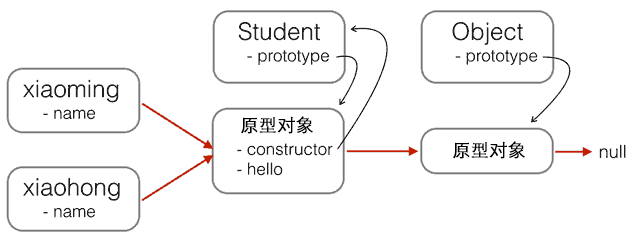对于构造函数
function Student(props) {
this.name = props.name || 'Unnamed';
}
Student.prototype.hello = function () {
alert('Hello, ' + this.name + '!');
}
Student的原型链:

我们要 基于Student扩展出PrimaryStudent。
最基础的方式
function PrimaryStudent(props) {
// 调用Student构造函数,绑定this变量:
Student.call(this, props);
this.grade = props.grade || 1;
}
但是,调用了Student构造函数不等于继承了Student,PrimaryStudent创建的对象的原型是:
new PrimaryStudent() ----> PrimaryStudent.prototype ----> Object.prototype ----> null
我们所需的是
new PrimaryStudent() ----> PrimaryStudent.prototype ----> Student.prototype ----> Object.prototype ----> null
如果你想用最简单粗暴的方法这么干:
PrimaryStudent.prototype = Student.prototype;
是不行的!如果这样的话,PrimaryStudent和Student共享一个原型对象,那还要定义PrimaryStudent干啥?
感觉它实际要达成的是
PrimaryStudent.prototype.prototype = Student.prototype;
同样的,
PrimaryStudent.prototype = Student
也是不对的。这样的话,一个prototype竟然指向了一个构造函数。
PrimaryStudent.prototype = new Student();
猜测感觉这样是行得通的。
然而不行,原因:
用Child.prototype = new Parent();替换了Child.prototype = new F();,免去了F()的定义。
这个代码对于大部分情况可能是正常的,但是,当你定义了一个这样的函数:
function Student(name) {
this.name = name.toUpperCase();
}
你的Child.prototype = new Parent()将直接报错,因为name是undefined,你不得不改成:
Child.prototype = new Parent('')
如果遇到另一种新的对象要传入number呢?
function Person(birth) {
this.age = 2016 - birth;
}
也就是说,你得为每个需要继承的对象编写特定的inherits()函数。
空函数F()能保证new F()正常执行,所有的继承用一个inherits()都能正常处理。
借助一个中间对象来实现正确的原型链
这个中间对象的原型要指向Student.prototype。为了实现这一点,参考道爷(就是发明JSON的那个道格拉斯)的代码,中间对象可以用一个空函数F来实现:
// PrimaryStudent构造函数:
function PrimaryStudent(props) {
Student.call(this, props);
this.grade = props.grade || 1;
}
// 空函数F,其实是一个构造函数,只是为空。
function F() {
}
// 把F的原型指向Student.prototype:
F.prototype = Student.prototype;
// 把PrimaryStudent的原型指向一个新的F对象,F对象的原型正好指向Student.prototype:
PrimaryStudent.prototype = new F();
// 把PrimaryStudent原型的构造函数修复为PrimaryStudent:
// 任何一个prototype对象都有一个constructor属性,指向它的构造函数。执行"PrimaryStudent.prototype = new F();"这一行的结果就是
// PrimaryStudent.prototype.constructor原本是指向PrimaryStudent的;执行之后,PrimaryStudent.prototype.constructor指向F。
PrimaryStudent.prototype.constructor = PrimaryStudent;
// 继续在PrimaryStudent原型(就是new F()对象)上定义方法:
PrimaryStudent.prototype.getGrade = function () {
return this.grade;
};
// 创建xiaoming:
var xiaoming = new PrimaryStudent({
name: '小明',
grade: 2
});
xiaoming.name; // '小明'
xiaoming.grade; // 2
// 验证原型:
xiaoming.__proto__ === PrimaryStudent.prototype; // true
xiaoming.__proto__.__proto__ === Student.prototype; // true
// 验证继承关系:
xiaoming instanceof PrimaryStudent; // true
xiaoming instanceof Student; // true
用一张图来表示新的原型链:

注意,函数F仅用于桥接,我们仅创建了一个new F()实例,而且,没有改变原有的Student定义的原型链。
如果把继承这个动作用一个extend()函数封装起来,还可以隐藏F的定义,并简化代码:
function extend(Child, Parent) {
var F = function () {};
F.prototype = Parent.prototype;
Child.prototype = new F();
Child.prototype.constructor = Child;
}
这个extend()函数可以复用:
function Student(props) {
this.name = props.name || 'Unnamed';
}
Student.prototype.hello = function () {
alert('Hello, ' + this.name + '!');
}
function PrimaryStudent(props) {
Student.call(this, props);
this.grade = props.grade || 1;
}
// 实现原型继承链:
extend(PrimaryStudent, Student);
// 绑定其他方法到PrimaryStudent原型:
PrimaryStudent.prototype.getGrade = function () {
return this.grade;
};
实验
function Fruit(name){this.name = name};
function Apple(sweet){this.sweet = sweet};
extend(Apple,Fruit);
Apple.prototype; //Fruit {}
Apple.name; //"Apple"
Apple instanceof Fruit; //false 它是一个构造函数
var aapple = new Apple(4);
aapple; //Apple {sweet: 4}sweet: 4__proto__: Fruit
aapple.name; //undefined
Object.name; //"Object"
发现一个严重的问题。name属性是一个预留属性。本来就会存在。改为pigu。
function Fruit(pigu){this.pigu = pigu};
Fruit.prototype.cate = "shuiguo";
function Apple(sweet){this.sweet = sweet};
extend(Apple,Fruit);
Apple; //Apple(sweet){this.sweet = sweet}
Apple.name; //"Apple"
Apple.prototype; //Fruit {}
Apple instanceof Fruit; //false
Apple.pigu; //undefined
var aa = new Apple(5);
aa.sweet; //5
aa.cate; //"shuiguo"
aa instanceof Apple; //true
aa instanceof Fruit; //true